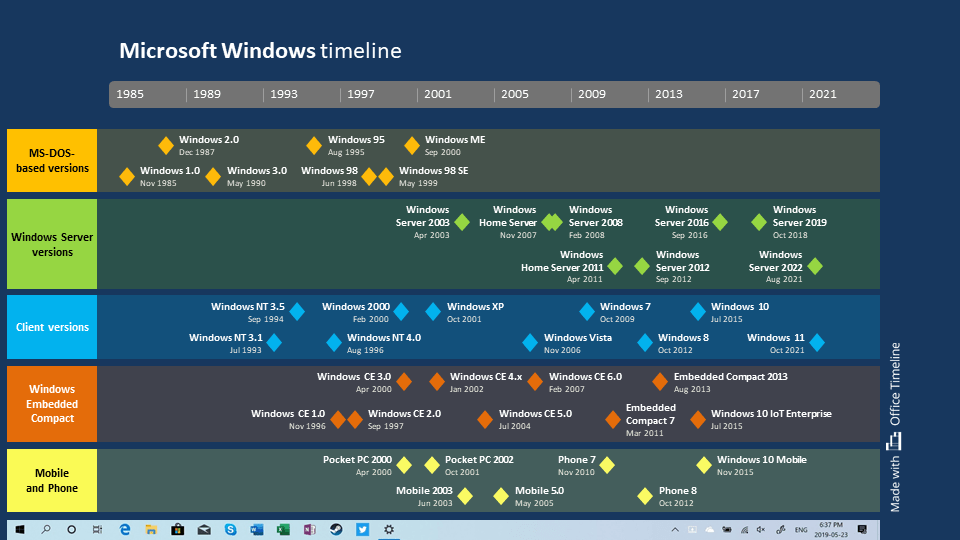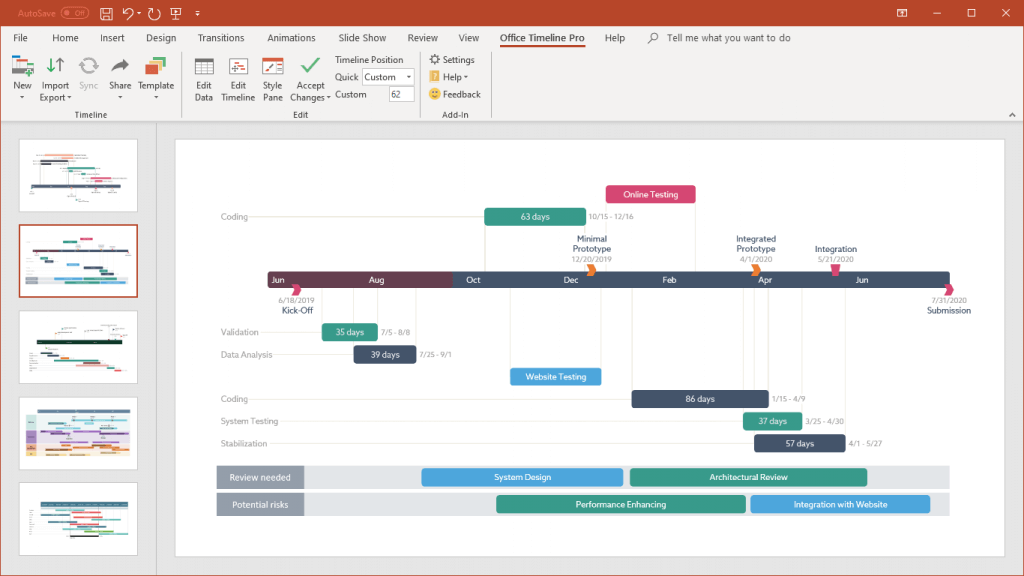Updated on July 28, 2022
Since its first release in 1985, the Microsoft Windows operating system has seen numerous adjustments and quite a few major transformations. Now, almost four decades later, the OS looks very different, but still familiar, with staple features that have survived throughout the years.
Let’s take a brief look into the history of the world’s most ubiquitous operating system, from its birth to the latest arrivals on the market. The Microsoft Windows timeline illustrates some of the most important releases in the history of the OS, from version 1.0, Windows 95 and the first mobile versions, to Windows 11 and Server 2022.

As an interesting fact, Windows 1.0, Microsoft’s first graphical user interface, was received poorly by critics because they considered it too mouse-focused (the mouse was relatively new at the time). It was Windows 95, released a decade later, that truly managed to cement the company’s dominance in the computer industry.
History of Microsoft Windows: a timeline
- 1985, November: Windows 1.0
- 1987, December: Windows 2.0
- 1990, May: Windows 3.0
- 1993, July: Windows NT 3.1
- 1994, September: Windows NT 3.5
- 1995, August: Windows 95
- 1996, August: Windows NT 4.0
- 1996, November: Windows CE 1.0
- 1997, September: Windows CE 2.0
- 1998, June: Windows 98
- 1999, May: Windows 98 SE
- 2000, February: Windows 2000
- 2000, April: Windows CE 3.0
- 2000, April: Pocket PC 2000
- 2000, September: Windows ME
- 2001, October: Windows XP
- 2001, October: Pocket PC 2002
- 2002, January: Windows CE 4.x
- 2003, April: Windows Server 2003
- 2003, June: Mobile 2003
- 2004, July: Windows CE 5.0
- 2005, May: Mobile 5.0
- 2006, November: Windows Vista
- 2007, February: Windows CE 6.0
- 2007, November: Windows Home Server
- 2008, February: Windows Server 2008
- 2009, October: Windows 7
- 2010, November: Windows Phone 7
- 2011, March: Embedded Compact 7
- 2011, April: Windows Home Server 2011
- 2012, September: Windows Server 2012
- 2012, October: Windows Phone 8
- 2012, October: Windows 8
- 2015, July: Windows 10
- 2015, November: Windows 10 Mobile
- 2016, September: Windows Server 2016
- 2018, October: Windows Server 2019
- 2021, August: Windows Server 2022
- 2021, October: Windows 11
Frequently asked questions about the history of Microsoft Windows
Here are the answers to some frequently asked questions about Microsoft Windows and its history.
The first version of the Windows OS was released in 1985, and it was a Graphical User Interface (GUI) offered as an extension of Microsoft’s existing disk operating system (MS-DOS). It was partially based on licensed concepts that Apple Inc. had used for its Macintosh System Software and included drop-down menus, scroll bars and other features.
Since its release, there have been several major versions of the Windows OS. Currently, Windows dominates the desktop PC market, with more than a billion active devices that run on the most recent Windows 11 and 10 systems.
Bill Gates, the co-founder of Microsoft, ran the development of Windows 1.0, the first version of this operating system.
In 1985, Microsoft introduced an operating environment named Windows. Although, in theory, Windows was designed to replace MS-DOS, it was in fact a graphical user interface running on top of MS-DOS.
There has been a multitude of versions of the Microsoft Windows OS since its first release in 1985.
We’ve put together a list of 14 of the major Windows versions that marked key OS updates:
· Windows 1.0 (1985)
· Windows 2.0 (1987)
· Windows 3.1 (1992)
· Windows NT (1993)
· Windows 95 (1995)
· Windows 98 (1998)
· Windows ME and 2000 (2000)
· Windows XP (2001)
· Windows Vista (2007)
· Windows 7 (2009)
· Windows 8 (2012)
· Windows 8.1 (2013)
· Windows 10 (2015)
· Windows 11 (2021)
Microsoft released a lot of intermediary Windows versions, developed for several main use categories:
1. Personal computer versions (totaling around 40, plus several cancelled)
2. Mobile versions (totaling around 17, plus several cancelled)
3. Server versions (totaling around 24)
4. Device versions (totaling around 16)
5. Embedded versions (totaling around 20)
This is a short history of Microsoft’s operating systems for mobile devices:
Windows Mobile operating systems developed by Microsoft for smartphones (currently discontinued) include the following versions:
· Windows CE
· Pocket PC 2000
· Pocket PC 2002
· Windows Mobile 2003
· Windows Mobile 2003 SE
· Windows Mobile 5
· Windows Mobile 6
· Windows Mobile 6.1
· Windows Mobile 6.5
Windows Phone (WP) mobile operating systems developed by Microsoft for smartphones as the replacement successor to Windows Mobile and Zune (currently discontinued) include the following versions:
· Windows Phone 7
· Windows Phone 8
· Windows Phone 8.1
· Windows 10 Mobile
The latest Microsoft OS for mobile devices is Windows 10 Mobile OS and is currently discontinued. Microsoft ended support for Windows 10 Mobile in 2020.
In 1985, Microsoft released the operating environment named Windows, which was a graphical user interface for MS-DOS. Bill Gates, the co-founder of Microsoft, is the person credited for its development.
Here is a list of the major Microsoft Windows versions ordered by release year:
· Windows 1.0 (1985)
· Windows 2.0 (1987)
· Windows 3.1 (1992)
· Windows NT (1993)
· Windows 95 (1995)
· Windows 98 (1998)
· Windows ME and 2000 (2000)
· Windows XP (2001)
· Windows Vista (2007)
· Windows 7 (2009)
· Windows 8 (2012)
· Windows 8.1 (2013)
· Windows 10 (2015)
· Windows 11 (2021)
Windows 11 is the most recent version of Windows for PCs, tablets and embedded devices. It was released in October 2021.
The most recent version for server computers is Windows Server 2022. It was released in August 2021.
Not anymore. The latest mobile version of the Windows OS is Windows 10 Mobile, released on February 12, 2015. It is a mobile operating system for smartphones and tablets with screens smaller than 8 inches. The last OS/security update was in 2020 and the OS is now in a declining phase.
Not for long. Windows 10 Mobile is a discontinued mobile operating system developed by Microsoft. First released in 2015, it is a successor to Windows Phone 8.1, but was marketed by Microsoft as being an edition of its PC operating system Windows 10.
About the Microsoft Windows timeline
The Microsoft Windows timeline was created using Office Timeline, a PowerPoint add-in that helps you build impressive timelines, schedules and charts fast and easily.
The illustration can be downloaded free of charge as a PowerPoint slide, and it is fully customizable. To edit or update the graphic, you can install the free trial of Office Timeline and add any milestones we might have missed. Or create your own timelines and roadmaps from scratch, all in a matter of minutes.

Turn project data into professional timelines
Get the advanced features of Office Timeline Pro+ free for 14 days.
Get free trial